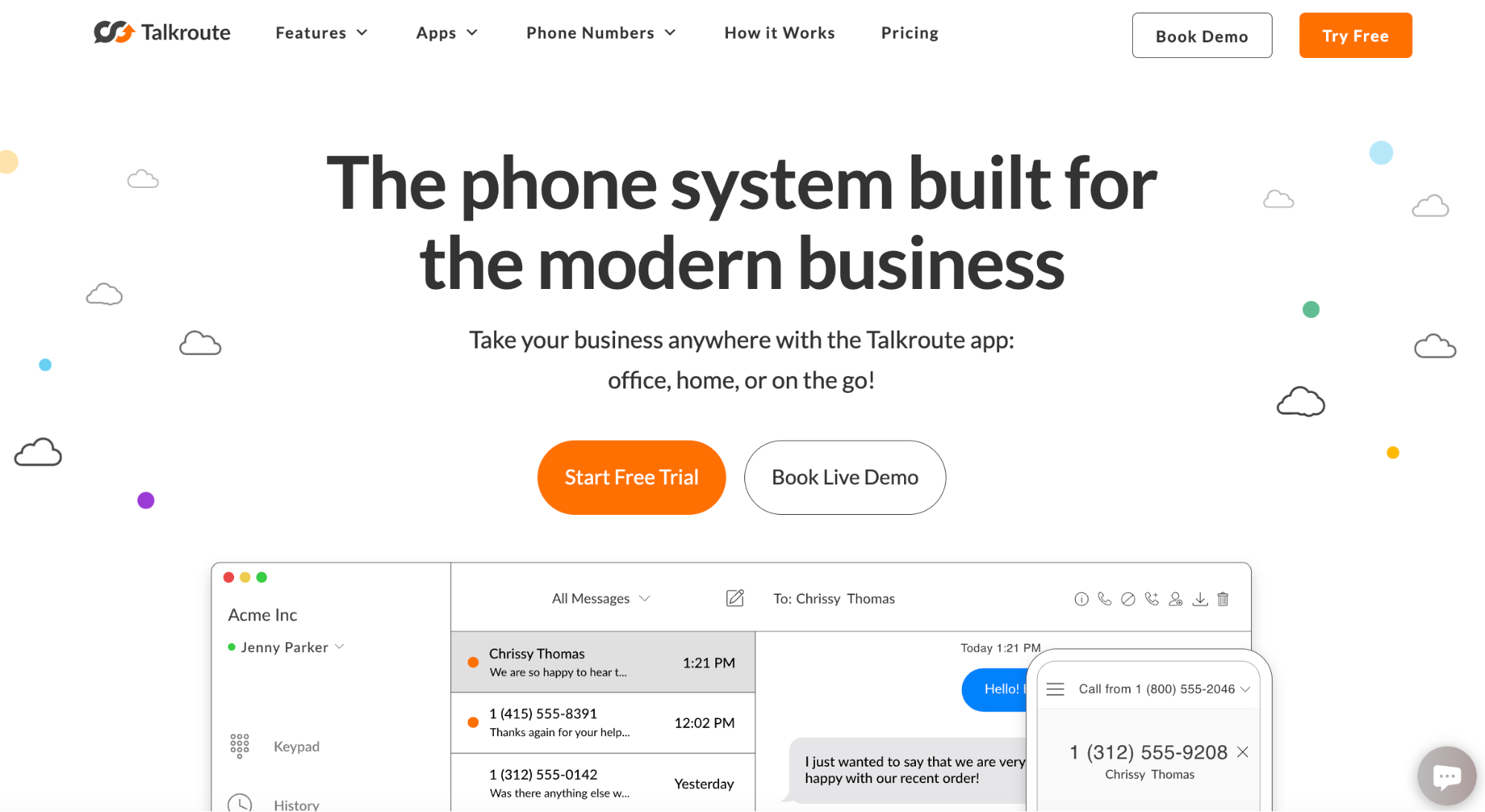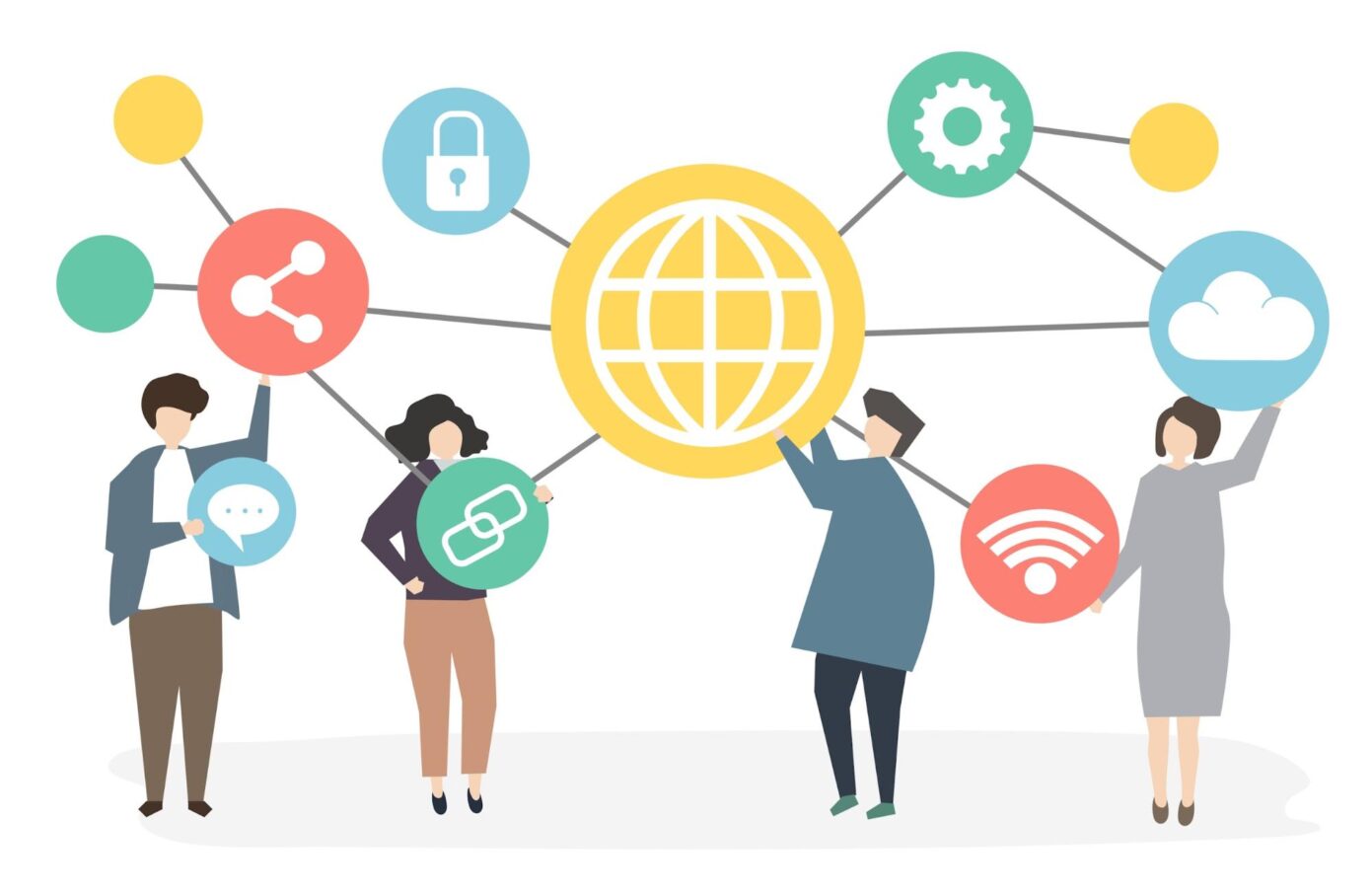Many businesses deal with messy communication setups. Calls drop. Messages get missed. Teams use too many tools that don’t work well together. One app is for chat, another for video meetings, and something else for phone calls.
It’s hard to keep everything running smoothly, especially with remote and hybrid work. This guide is here to help you fix that.
We’ll explain what UCaaS is, how it works, and why more companies are using it to bring everything into one system.
What is Unified Communications as a Service (UCaaS)?
Unified Communications as a Service (UCaaS) is a cloud-based service that combines different communication tools, like calls, messages, and video, into one platform.
With UCaaS, businesses can manage all their communications services in one place without needing complex hardware.
This setup is helpful for both small teams and large companies. It makes enterprise communications easier to handle and supports remote or hybrid work. Unified communications (UC) solutions like UCaaS help teams stay connected and work faster.
Because everything runs in the cloud, updates and new features are added automatically. That means fewer IT problems and lower costs.
As more businesses move away from old phone systems, UCaaS is becoming a smart choice for modern communication.
How Does UCaaS Work?
UCaaS uses the Internet Protocol to support both real-time and delayed communication. This lets your team make calls, send messages, or join video meetings from any device, at any time.
Here’s how it works:
- Runs on cloud-based servers: Managed by UCaaS providers and hosted in data centers or cloud platforms like AWS, Google Cloud, or Microsoft Azure
- Uses software and web apps: Teams connect through downloaded apps or web browsers with WebRTC or a plugin
- Works on many devices: Phones, laptops, and video gear all connect to the platform
UCaaS uses VoIP technology instead of traditional phone systems. It combines calling, messaging, meetings, and app integrations into one integrated communications setup.
Types of UCaaS Solutions
Businesses can pick from different UCaaS setups based on their needs. These options affect how the service is managed, how secure it is, and how flexible it can be.
The three main types are single-tenant, multi-tenant, and hybrid.
Single-Tenant
In a single-tenant setup, each business gets its own private version of the UCaaS system. This means full control over data, security settings, and the selection of UCaaS features to use.
It also allows for more custom integrations. Businesses in healthcare, government, or finance often prefer this model because they must follow strict privacy and security rules.
Multi-Tenant
A multi-tenant UCaaS system is shared by many businesses. While it limits customization, it keeps costs low and is easier to manage.
The provider handles updates, security, and maintenance. This setup is best for companies that want affordable access to real-time communication tools without needing full control of the system.
Hybrid
Hybrid UCaaS blends both models. Some parts of the system run in the provider’s cloud, while others stay on the business’s network.
This setup gives companies more flexibility and control, while still offering the wide UCaaS features of a shared system.
It’s useful for organizations that want strong data control without giving up access to cloud-based tools.
Check out the demo and find out how Talkroute streamlines your team’s day-to-day communication.
Why Do Businesses Use UCaaS?
As more teams rely on remote work, UCaaS adoption continues to grow because it offers flexibility, ease of use, and better support for teams and businesses with a distributed workforce.
Here’s a closer look at why so many businesses are turning to UCaaS:
Better Communication Across Teams
UCaaS brings voice calls, secure video conferencing, team messaging, file sharing, and screen sharing into one simple system. Teams no longer have to jump between apps or deal with tools that don’t work well together.
Everyone can use the same platform, which keeps communication clear and smooth. Whether a team is working in the same office or across time zones, they can talk, share, and work together without delays or confusion, resulting in improved collaboration in the workplace.
Supports Remote and Hybrid Work
Today, many businesses no longer expect everyone to work from one office. With UCaaS, employees can stay connected from home, at the office, or while traveling.
The same tools and features are available across all devices, including laptops, smartphones, and tablets. This makes it easier for teams to stay productive and responsive, no matter where they are.
For companies embracing flexible work, UCaaS helps make that shift possible without losing communication quality.
Managing a remote workforce? Book your live demo and explore how Talkroute keeps everyone connected.
Easier to Manage
Running a traditional phone system often means dealing with cables, hardware, and lots of IT support. UCaaS removes that burden. All updates, upgrades, and security tasks are handled by the provider.
Businesses don’t need to manage hardware or software on their own. This also reduces downtime and tech headaches.
IT teams can shift their focus to more important business processes, like supporting staff or improving tools for other departments.
Grows With Your Business
As your company grows, UCaaS can grow with you. You don’t need to buy new servers or hire extra tech staff just to add more users. You can increase or reduce the number of users anytime. Adding new features is also easy.
Whether you’re opening a new office or hiring remote workers, the system can scale without any major changes. This flexibility makes it a strong choice for businesses at any stage of growth.
Saves Money
Using UCaaS often costs less than managing several communication channels or running a private phone network. You pay one monthly fee, and it covers all the major collaboration tools your team needs. There’s no need to invest in expensive hardware, licenses, or setup services.
Plus, because it’s one of the cloud-based UC solutions, you don’t have to worry about upgrade costs or surprise maintenance bills. The pricing is predictable, which helps with planning and budgeting.
Start your trial today and see how Talkroute handles business communications in one place.
UCaaS vs. CCaaS vs. CPaaS: What’s the difference?
There are several cloud-based communication models available today, and each one serves a different purpose. UCaaS, CCaaS, and CPaaS may sound similar, but they support different parts of a business.
Understanding how they compare can help you choose the right solution for your team, your customers, or your software.
Here’s a quick look at how these three models stack up:
|
Model |
What It Does |
Who It’s For |
Key Features |
|---|---|---|---|
|
UCaaS (Unified Communications as a Service) |
Combines internal communication tools into one platform |
Businesses that want to improve team collaboration |
Voice calls, video meetings, chat, file sharing, and mobile access |
|
CCaaS (Contact Center as a Service) |
Helps customer support teams and call centers manage interactions |
Businesses that handle large volumes of customer communication |
Call routing, live chat, IVR, CRM integration, analytics |
|
CPaaS (Communications Platform as a Service) |
Lets developers build custom communication tools into apps |
Companies with specific software needs or custom workflows |
APIs for SMS, voice, video, push notifications, and app integrations |
Key Features of UCaaS Solutions
UCaaS platforms are designed to support both everyday tasks and larger business goals, all in a single, easy-to-manage solution.
Below are the key features you can expect from a strong UCaaS platform.
Cloud-Based Phone Service
A key part of every UCaaS platform is its phone service. Using VoIP technology, UCaaS solutions allow employees to make and receive calls over the internet using desktop phones, mobile devices, or laptops.
One of the key advantages of using VoIP technology is that there’s no need for traditional phone lines or costly hardware.
Teams can stay connected whether they are at the office, working from home, or on the road. Features like voicemail, call history, and caller ID are often included, giving businesses the benefits of a full phone system without the hassle of managing it.
Call Forwarding
Call forwarding keeps calls moving when someone is away or unavailable. You can easily transfer incoming calls to another number, device, or team member.
This is especially useful for companies that handle a high call volume or have remote staff who need to stay reachable. It helps avoid missed calls and keeps customer service running smoothly.
Text Messaging
Many UCaaS platforms include text messaging so team members can send fast updates or start group conversations. This feature is useful for sharing quick info or following up without needing to make a call or write a long email.
Some platforms also allow sending texts to customers, which can help with appointment reminders, updates, or support messages.
Advanced Collaboration Features
UCaaS solutions come with a wide range of advanced collaboration features to help teams work together in real time. These include video conferencing, screen sharing, shared calendars, and team chat.
These tools help people connect, share ideas, and solve problems more efficiently. Teams don’t have to switch between apps or wait for delayed responses. Everything they need to communicate is in one place.
Third-Party Integrations
A big advantage of UCaaS is its ability to work with other tools your business already uses. Many platforms offer third-party integrations with popular business apps like Microsoft Teams, Google Workspace, Slack, Salesforce, and project management tools.
These connections make it easier for employees to schedule calls, join meetings, or send updates directly from their main workflow. It saves time and keeps communication organized across the business.
End-to-End Encryption
Security is a top concern for any business. UCaaS platforms often include end-to-end encryption, which helps protect calls, messages, and shared files.
Only the people involved in a conversation can access the content, which helps reduce the risk of data breaches.
This feature is especially important for industries that deal with sensitive information, such as healthcare, finance, or legal services.
Watch how easy it is to run calls, meetings, and team chats all from one dashboard.
Picking the Right UCaaS Provider for Your Business
Choosing the right UCaaS provider can improve communication, reduce tech issues, and help your team work better together. Here are key steps to help guide your decision and setup process.
Look for a Reliable Network Infrastructure
A strong provider should offer a robust network infrastructure with multiple data centers and built-in backup options.
This setup helps keep calls and video meetings running smoothly, even during peak times or outages. If your business relies on many phone lines or supports a large team, steady performance is key.
Ask About Implementation Services
Implementing UCaaS software takes planning and time. Many providers offer implementation services that help with setup, number transfers, system configuration, and training.
These services are especially helpful for companies moving from older systems or adopting a new UCaaS phone system for enterprises.
Involve End Users Early
Before you roll out a new platform, it helps to involve end users early. Ask your team what works, what doesn’t, and what tools they already use.
Their input can guide the setup and improve adoption later. Choosing tools based on real needs makes the switch smoother and more useful for daily work.
Gather Feedback and Adjust
Once your UCaaS system is in place, check in with users regularly. Gather feedback on call quality, ease of use, and which features get used the most.
You can often fine-tune settings or make small upgrades to improve the experience. A flexible provider will support this kind of ongoing improvement.
Test the System Before Full Launch
Before making the switch company-wide, run tests. Make calls, try video meetings, and use messaging features from different devices. This step confirms that everything works as expected and that your setup meets your team’s daily needs.
For teams that manage customer support or high volumes of communication, it’s also a good idea to check that the system aligns with call center standards.
Recommended reading:
IVR Phone System: What It Is + 4 Steps To Set It Up
What Is 10DLC? The Complete Guide for Small Businesses
Make Business Communication Simple and Clear

Talkroute helps your team talk, text, and meet from anywhere using one easy app. Whether you’re in the office or working remotely, everything stays connected.
You can forward calls, set up menus, join video meetings, and manage messages. All without needing new equipment.
This is how enterprise communications should work. No confusing tools. No switching between platforms. Just a seamless communication experience across all your devices.
Here’s why businesses choose Talkroute
- All-in-one system – Talk, text, and meet using one simple platform.
- Seamless communication experience – Stay connected on desktop, mobile, or browser without missing a beat.
- Smarter call routing – Forward calls to the right person or device with flexible settings.
- Hold video meetings anywhere – Meet with your team or clients without extra tools.
- Text from your business number – Use your local or toll-free number to message customers.
- Simple voicemail and call recording – Get alerts, transcriptions, and unlimited storage.
- Set team permissions – Control who sees and manages calls, texts, and voicemails.
- No special hardware required – Use the devices you already have.
Talkroute gives your team everything they need to stay connected and work better together. It’s a modern, flexible phone system made for real businesses.
Try Talkroute today and give your business the seamless communication experience it deserves.
FAQs About Unified Communications as a Service
What is unified communications as a service?
Unified communications as a service (UCaaS) is a cloud-based system that brings together many communication tools like instant messaging, voice calls, video meetings, and file sharing into one unified platform.
It helps remote workers and customer support teams stay connected with minimal tech resources.
UCaaS platforms integrated with project management tools and built on a strong network make business communications simple and flexible.
What is the difference between UCaaS and CCaaS?
UCaaS focuses on internal employee communication like voice calls, online meetings, and instant messaging, while CCaaS is built for customer-facing teams and contact centers. Both use a cloud delivery model, but UCaaS helps with team collaboration and seamless communication.
CCaaS improves customer experience with tools like call routing and analytics for customer data. UCaaS supports daily business communications, and CCaaS supports customer interactions.
What is the difference between UC and UCaaS?
Unified communications (UC) refers to a setup that brings many communication tools together into one system, often installed on-site. Unified communications as a service (UCaaS) works the same way but is delivered through the cloud by a service provider.
UCaaS solutions are easier to manage, more flexible, and better for a hybrid workforce. They also offer cost savings and business continuity with less need for in-house tech support.
Is Zoom a UC platform?
Yes, Zoom is a unified communications platform. It combines instant messaging, video conferencing, phone calls, and online meetings in one place.
As a UCaaS provider, Zoom helps sales teams, support teams, and remote workers stay connected.
However, a better choice would be Talkroute. This phone system platform supports digital transformation by offering a simple way to manage all communication channels using a reliable internet connection.

Stephanie
Stephanie is the Marketing Director at Talkroute and has been featured in Forbes, Inc, and Entrepreneur as a leading authority on business and telecommunications.
Stephanie is also the chief editor and contributing author for the Talkroute blog helping more than 200k entrepreneurs to start, run, and grow their businesses.




